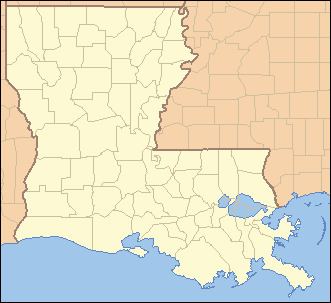Location State of Louisiana Government Parish government | Number 64 Parishes | |
 | ||
Category Second-level administrative division Populations 4,908 (Tensas Parish) – 440,171 (East Baton Rouge Parish) Areas 203 square miles (530 km) (West Baton Rouge Parish) – 2,429 square miles (6,290 km) (Plaquemines Parish) | ||
The U.S. state of Louisiana is divided into 64 parishes (French: paroisses) in the same way that 48 other states of the United States are divided into counties. Alaska, the other exception, is divided into boroughs and census areas instead.
Contents
Forty-one parishes are governed by a council called the Police Jury. The other 23 have various other forms of government, including: president-council, council-manager, parish commission, and consolidated parish/city.
History
Louisiana was formed from French and Spanish colonies, which were both officially Roman Catholic. Local colonial government was based upon parishes, as the local ecclesiastical division (French: paroisse; Spanish: parroquia).
Following the Louisiana Purchase in 1803, the territorial legislative council divided the Territory of Orleans (the predecessor of Louisiana state) into 12 counties. The borders of these counties were poorly defined, but they roughly coincided with the colonial parishes, and hence used the same names.
On March 31, 1807, the territorial legislature created 19 parishes without abolishing the old counties (which term continued to exist until 1845). In 1811, a constitutional convention was held to prepare for Louisiana's admission into the Union. This organized the state into seven judicial districts, each consisting of groups of parishes. In 1816, the first official map of the state used the term parish, as did the 1845 constitution. Since then, the official term for Louisiana's primary civil divisions has been parishes.
The 19 original parishes were joined by Catahoula Parish in 1808, and four additional parishes were created by the new West Florida territory.
By April 1812, Attakapas Parish became St. Martin Parish and St. Mary Parish. On April 30, the state was admitted to the Union with 25 parishes.
By 1820, Washington Parish was added, and Feliciana Parish split into West and East in 1824. The next year, Jefferson Parish was carved from Orleans Parish. By 1830, Claiborne Parish was created, and the old Warren Parish was mostly absorbed into Ouachita Parish, only to return as Carroll Parish a few years later.
In 1838, Caddo Parish was created from Natchitoches, as were Madison and Caldwell parishes in the east. In 1839, Union Parish was formed from Ouachita, and Calcasieu was formed from St. Landry in 1840.
Five parishes were created in 1843: Bossier, DeSoto, Franklin, Sabine, and Tensas. Morehouse Parish and Vermilion Parish were formed from Ouachita and Lafayette parishes, respectively, in 1844. The next year, Jackson Parish was formed, the old county units were abandoned, and the units were officially referred to as "parishes". In 1848, Bienville Parish was formed from Claiborne Parish. In 1852, Winn parish was formed, while parishes further south added and lost land.
In 1853, Lafourche Interior Parish was renamed to Lafourche Parish. During Reconstruction, state government created a number of new parishes, with the first being Iberia and Richland parishes. Plans for creating a parish like Iberia from St. Martin and St. Mary parishes had dated from the 1840s. Tangipahoa and Grant parishes followed in 1869. In 1870, the fifth Reconstruction parish, Cameron, was created, which was followed by the sixth, seventh, and eighth parishes (Red River, Vernon, and Webster, respectively) in 1871. The ninth parish to be formed under Radical Republican rule was Lincoln, named after the late president and formed in 1873. In 1877, the old parish of Carroll divided into East and West Carroll parishes, which are unofficially called the tenth and eleventh Reconstruction parishes, as the project ended that year.
No new parishes were formed until 1886, when Acadia Parish was formed from St. Landry. Again, no new parishes were formed, this time until 1908, when the western half of Catahoula parish became LaSalle parish.
In 1910, the parish count rose to 61 with the creation of Evangeline Parish, and the 62nd, 63rd, and 64th parishes (Allen, Beauregard, and Jefferson Davis) were created from areas of Calcasieu Parish. There were several minor boundary changes afterward, the most substantial being the division of Lake Pontchartrain among Tangipahoa, St. Tammany, Orleans, Jefferson, St. John the Baptist, and St. Charles Parishes in 1979.
Former parishes
Counties in 1803
The original twelve counties (later, parishes) defined by the Territorial Legislative Council in 1803 were:
In 1807, German Coast County was divided into several different parishes, when the Territorial Council revised the list from 12 to 19. Similarly, in 1811 Attakapas County was subdivided. The names German Coast and Attakapas were dropped when the counties were divided, merged or changed into parishes.
